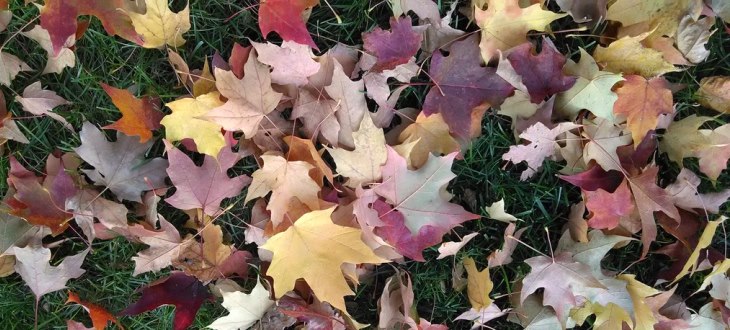The State We're In
Leave the autumn leaves
Autumn is here, and the leaves will soon be down. Time for a massive yard cleanup, right?
Not so fast! Before you go for the rake, blower and bags, you should know that you can help keep your lawn and soils healthy – and give yourself a break!
Those brilliant red, gold and orange leaves fluttering from trees aren’t trash to be collected and hauled away. Rather, they’re nature’s own fertilizer.
All it takes is some mowing without a collection attachment. Your mower can chop fallen leaves into small pieces so they naturally decompose into organic nutrients that nourish your lawn.
“A lawn is a living system, it’s not a piece of pavement,” says Dr. Emile DeVito, New Jersey Conservation Foundation’s staff biologist, who comes from a family of landscapers. “If you’re carting away all the leaves, you’re not doing anything to help the lawn.”
Healthy soils are alive, he explained, composed of minerals, organic matter and organisms that break down organic matter. The organic matter also holds moisture in the soil.
Many homeowners fall into a vicious cycle of removing the leaves and grass clippings, and then applying chemical fertilizers to replace the natural processes.
So how about doing your lawn – and yourself – a favor this fall by chopping up leaves and leaving them there. “It will look fine once you turn the leaves into a fine mulch with your mower, and your lawn will survive the onslaught of winter much better,” says Emile. “You’ll get a better lawn by utilizing the decomposing activity of the leaf-shredding organisms that live in a healthy, organic soil.”
Shredded leaves are also great to spread on garden beds, and shredded or whole leaves can be used as mulch around the base of shrubs.
As a bonus, a lawn grown with few or no chemical fertilizers, pesticides, herbicides, or fungicides, will help birds by supporting and protecting the insects they eat.
You can also help wildlife by leaving dead flowering plants in your garden and along the edge of your lawn. Many native blooms – such as black-eyed Susans, asters, coneflowers and thistles – have seed heads that provide food for foraging birds in winter if left standing.
With all the time you save by not raking and removing leaves, here are a few things you can do instead:
- Create a brush pile. Instead of getting rid of tree branches blown down by autumn winds, pile them up in a corner of your yard. The brush pile will shelter birds and small mammals from winter’s cold, and also give them a place to hide from predators.
- Remove invasive non-native plants. Invasive species displace native plants that provide food and habitat for wildlife. One of the worst is Japanese barberry, recognizable in fall by its bright scarlet berries. Winged euonymus, also known as burning bush, is another highly recognizable invasive this time of year because of the pinkish-red color of its leaves. The New Jersey Invasive Species Strike Team has a full list of invasive plants that should be taken out.
- Plant natives. The cool, crisp days of fall are a great time to plant native trees and shrubs. Dogwood and spicebush are New Jersey natives that produce nutritious fruit for birds during their fall migration. Junipers, bayberries, hollies, hawthorns and sumacs produce fruits and berries eaten by birds during cold weather. While you’re visiting your local nursery, you may be lucky enough to find bargains on leftover perennial flowers that will bloom next spring.
To learn more about creating bird-friendly landscaping, go to the National Audubon Society website at https://www.audubon.org/native-plants.
To find out more about invasive plants, visit the New Jersey Invasive Species Strike Team’s website at https://www.fohvos.info/invasive-species-strike-team/.
And for information on preserving New Jersey’s land and natural resources, visit the New Jersey Conservation Foundation website at www.njconservation.org or contact me at info@njconservation.org.
About the Authors
Alison Mitchell
Co-Executive Director
John S. Watson, Jr.
Co-Executive Director
Tom Gilbert
Co-Executive Director, 2022-2023
Michele S. Byers
Executive Director, 1999-2021
View their full bios here.
Filter
Get The Latest News
From The Garden State
In the
News

